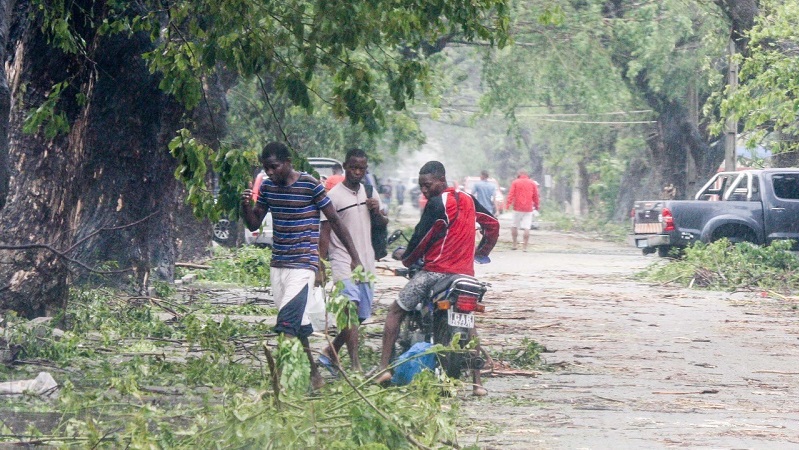Nearly two years after it was hit by devastating cyclones, debt-ridden Mozambique’s recovery effort is backsliding as it is battered by another powerful tropical storm.
More than 250,000 people are estimated to have been affected by cyclone Eloise, which made landfall on 23 January in the central Sofala province, according to the UN.
At least 18,000 people have been internally displaced and the number of affected people continues to rise amid ongoing floods. Dozens of health facilities and more than 320 classrooms have been damaged and 142,000 hectares of crops have flooded, according to the Red Cross.
This is the second tropical storm to hit central Mozambique in less than a month, after tropical storm Chalane made landfall in December. With the risk of Covid-19 infections spreading through rescue shelters, the Red Cross has launched an international appeal for funds.
“It’s a catastrophe,” Hastings Kandaya, operation support manager for the Red Cross in Mozambique, told Climate Home News. Displaced people are living in crowded conditions in rescue centres where they are unable to keep distance to avoid exposure to Covid-19, he said.
Carney’s carbon offset taskforce ducks environmental integrity questions
Humanitarian and development agencies have worked to rebuild this central region from the devastation caused by cyclone Idai two years ago. The tropical storm killed over 1,000 people and destroyed more than 100,000 homes when it swept through Mozambique in March 2019. Nearly 100,000 people were still waiting to be resettled when cyclone Eloise struck, according to the Red Cross.
Food vouchers and financial support to buy farming equipment and fishing nets were still being delivered to help thousands of people rebuild their livelihoods.
“With the coming of Eloise, most of that has been destroyed again. The effort for recovery has backtracked,” said Kandaya.

Flooded cropland outside Beira (Photo: Horizont3000)
Climate projections in the region point to an increase in the intensity of heavy rainfall across the country. Jennifer Fitchett, from the University of the Witwatersrand in South Africa, told Climate Home that the South Indian Ocean had seen an increase in high intensity storms – a trend, she said, linked to climate change.
“And climate change is likely to continue to heighten the probability of higher intensity tropical storms,” she added.
But “people here are not prepared for more frequent intense storms,” said Jan Wiesenmüller, country manager for the Austrian development agency Horizont3000 in Mozambique.
Speaking to Climate Home from the low-lying coastal city of Beira, Wiesenmüller said much of the damage to public infrastructure had not been repaired after cyclone Idai. “The energy supply has never been the same,” he said.
Many people who were displaced by the storms nearly two years ago are still living in makeshift camps on the outskirts of Beira, he added.
Since cyclone Eloise made landfall, “a big part of the city is still under water without electricity,” he said, adding that in the poorest quarters of the city, there is no clean water.
“Development is stuck – the tendency is towards a deterioration rather than going in a positive way. We are still working in an emergency. It’s a quiet catastrophe,” he said, citing the lack of international attention to the struggle for recovery.

A man sits on a tin-roof in Beira (Photo: Horizont3000)
Meanwhile, seven countries have backed a $20bn project led by Total to extract, liquefy and export methane gas from the northern province of Cabo Delgado. The region is facing an Islamic insurgency and was hit by cyclone Kenneth in April 2019 – the strongest storm to make landfall on the African continent, five weeks after Idai.
Slow disbursement of international funds following the 2019 cyclones is partly responsible for the ongoing recovery effort, Kandaya said.
The lack of funds in the first place hindered efforts, said Marie David, acting assistant country director for Care International in Mozambique. Funds have been made available for less than half of the humanitarian response needed, she said, adding that a lot more money is needed to build resilience in the long-term.
But that could prove difficult. In 2019, cyclones Idai and Kenneth pushed Mozambique’s public debt to almost 110% of its GDP, as the International Monetary Fund granted the country an $118 million interest-free loan for rebuilding.

Aerial view of the area around Beira (Photo:Horizont3000)
The coronavirus pandemic deepened the debt burden creating vast expenditures to address the health and economic crises and a shortfall in revenues.
In a letter to the IMF in April, Mozambique’s economy minister Adriano Afonso Maleiane wrote that the economic and financial impacts of Covid-19 had “dashed prospects of a nascent economic recovery from the devastating impact of tropical cyclones Idai and Kenneth in 2019” and asked for more support.
The IMF approved a further $309 million loan in emergency assistance to help the country balance the books. But it acknowledged that given the country’s limited fiscal space and high public debt “additional external support, preferably in the form of grants and highly concessional loans, is also urgently required”.
Marcia Cossa, head of humanitarian programmes at ActionAid Mozambique, told Climate Home News that she was concerned funds from the IMF designed to rebuild the country had failed to reach the poorest and most vulnerable communities and instead pushed the country “further into debt and poverty”.
Cyclone Eloise, which tore through the same communities, “is a stark reminder of the urgent need for climate finance in the form of grants for countries on the frontlines of climate change,” she said.
“Strong accountability systems at local and national levels are also vital to ensure that marginalised communities and those hardest hit benefit most,” she added.
